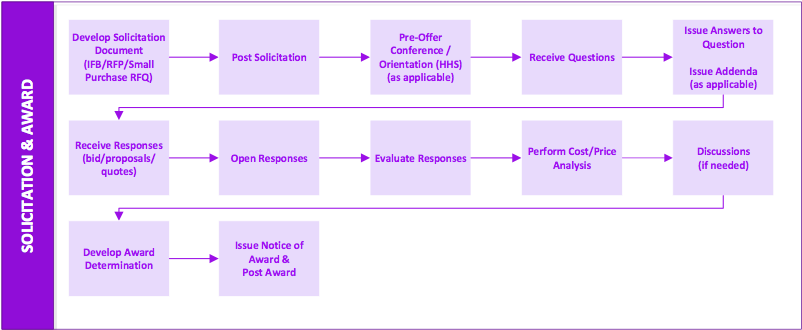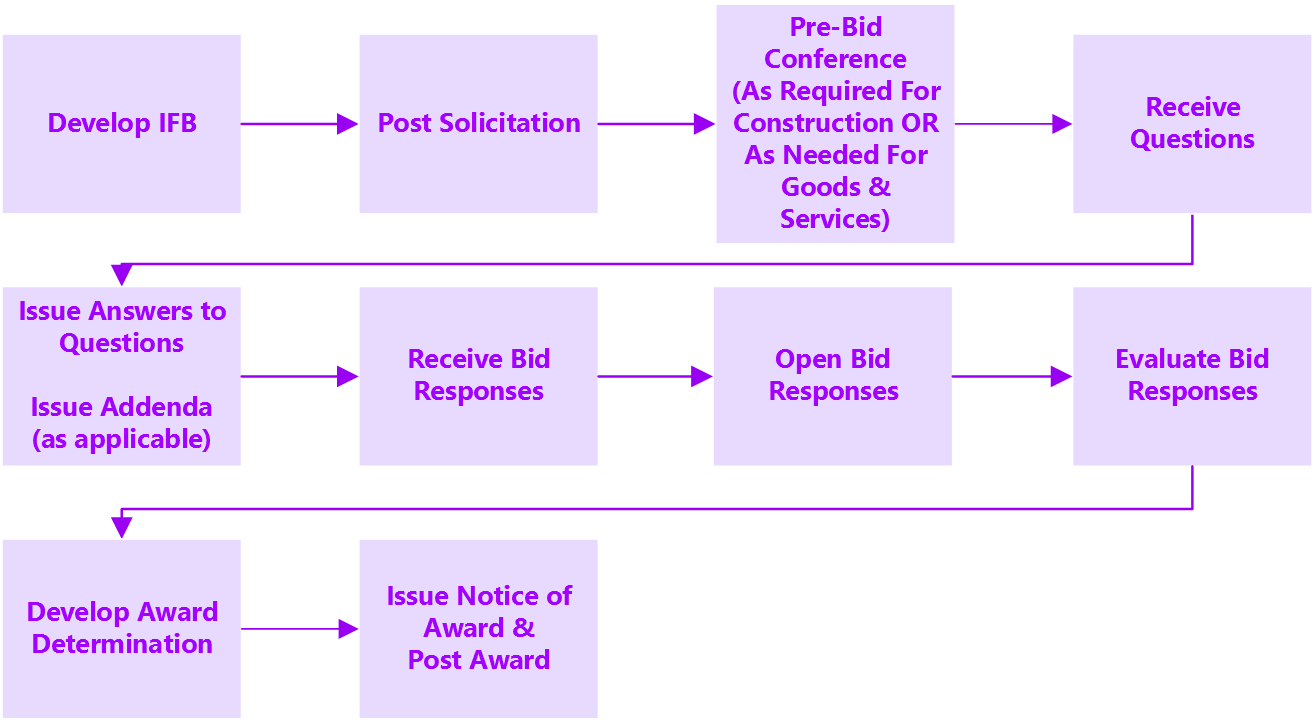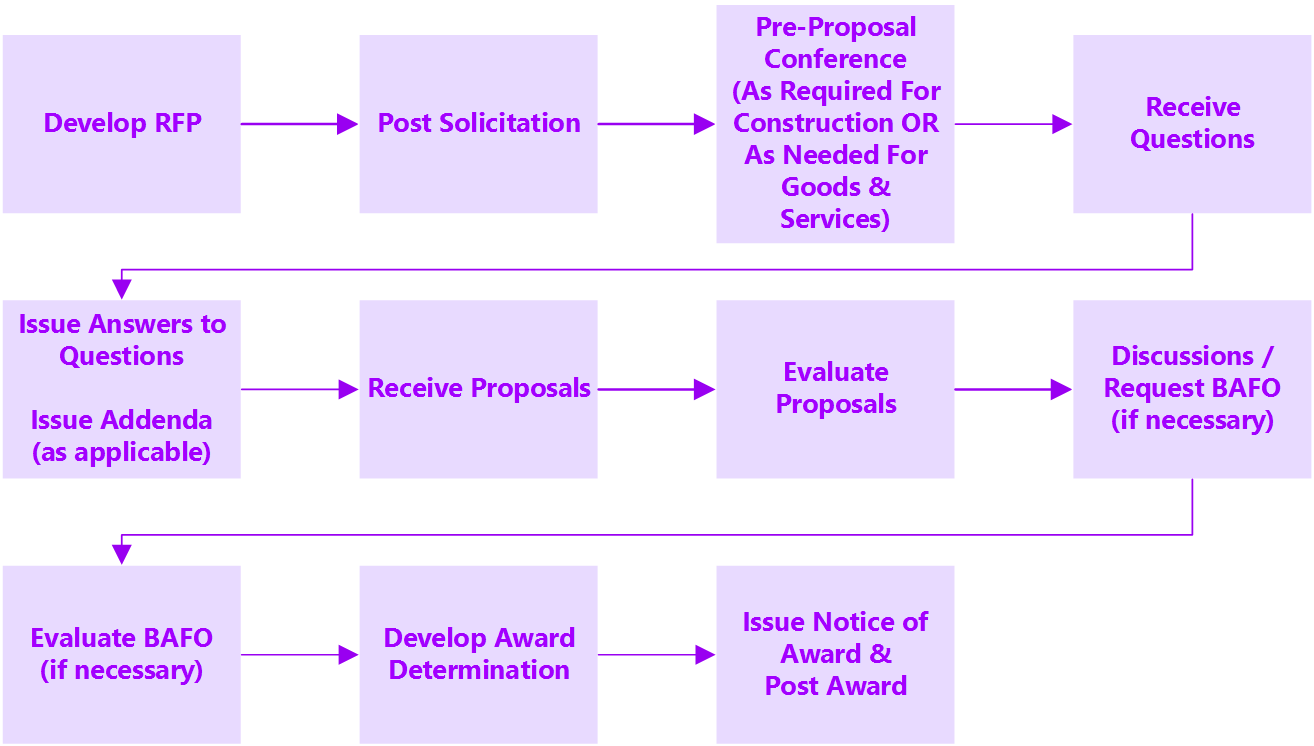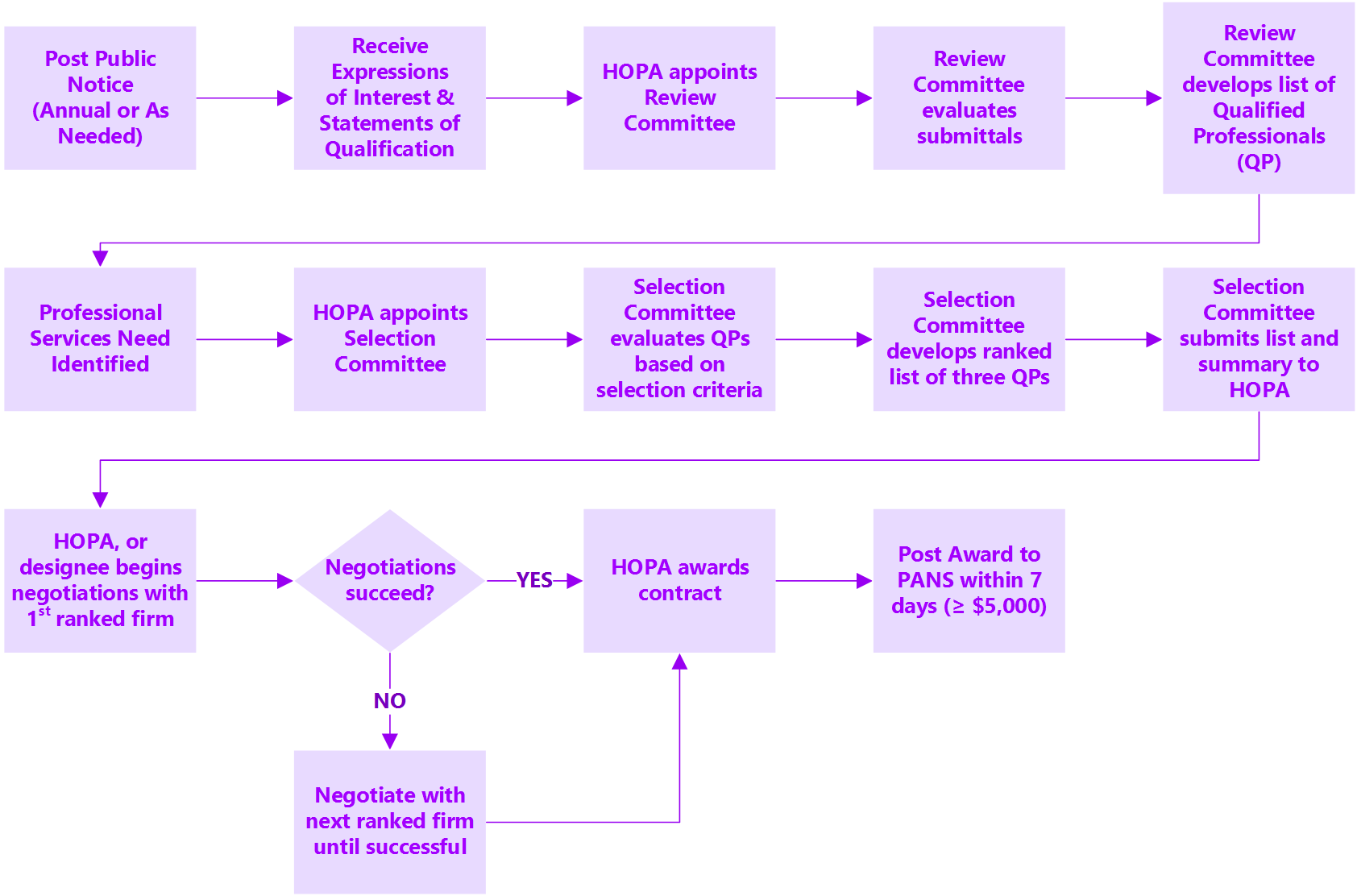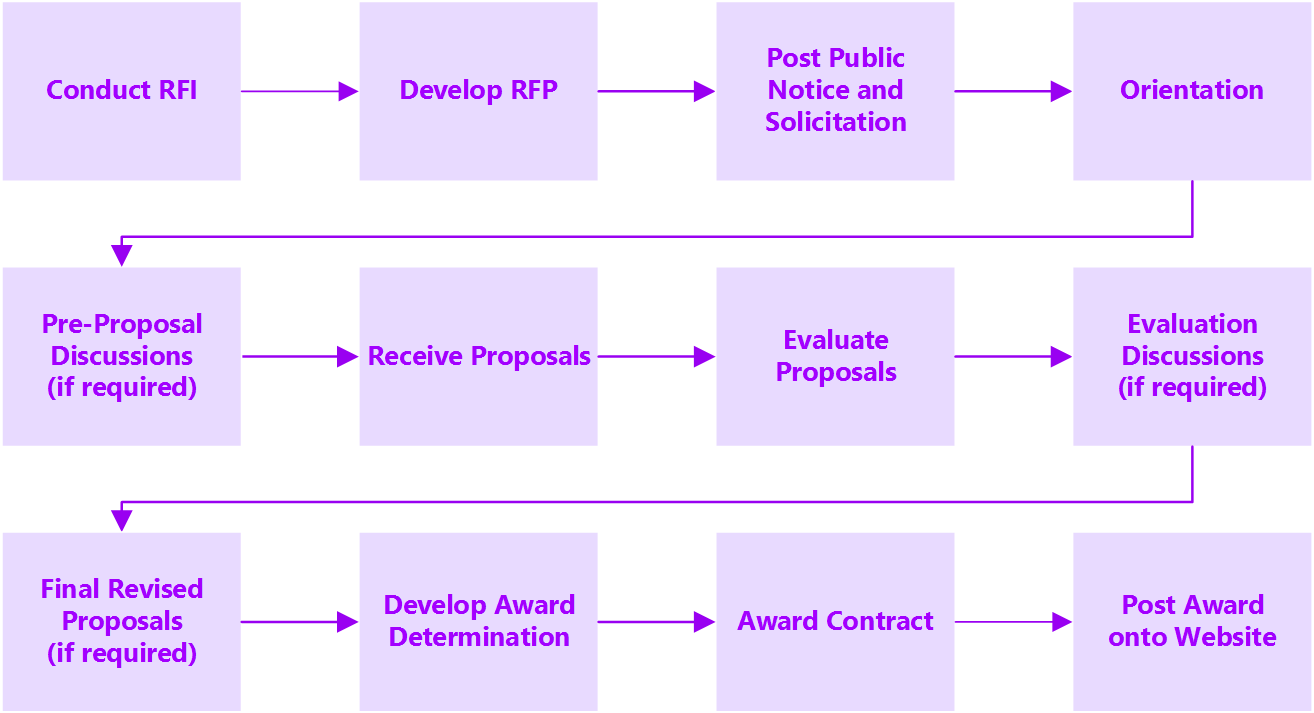4.7 Other Procurement Considerations Prior to Award
((Requirements discussed in this Section do not apply to procurements conducted under HRS 103F.))
4.7.1 Preferences
The State of Hawaii has several statutory preferences an agency must consider as it develops a solicitation document and evaluation plan. Each of these preferences may impact an agency’s solicitation or the evaluation of the bid or price submitted in response to the solicitation. Preferences apply to Requests for Sealed Bids and Requests for Sealed Proposals for goods, services and construction.
Should more than one statutory preference apply, the evaluated price shall be based on application of applicable preferences in the order specified below. The sum of the preferences, where applicable, shall be applied to the original price, except that preferences (1) and (4) shall be subtracted from the specific Hawaii products or recycled products proposed price only.
- Hawaii products list
- Tax adjustment for tax exempt offerors
- Preferred use of Hawaii software development businesses
- Recycled products
- Reciprocal preference
- Printing, binding, and stationery work within the State
- Persons with disabilities
- Apprenticeship program preference under HRS 103
A description of these preferences, their application, and their consideration in the evaluation process is provided below.
4.7.1.1 Hawaii Products
To encourage the procurement of products produced or manufactured within the state, the State of Hawaii seeks to award contracts to the lowest responsible and responsive bidders, with preference given to qualified and registered Hawaii products. In Request for Proposals this preference shall apply to price evaluation.
In developing an IFB/RFP, the Procurement Team must consider if any of the specifications required by the solicitation can be provided with Hawaii products. If so, the IFB/RFP must include a description of the products that are listed in the Hawaii products list that may be used to complete the scope of work specified in the solicitation. Alternatively, the procurement officer may allow the respondent to self-certify that the Hawaii products they are providing qualify for preference in response to the solicitation. Procurement Officers should ensure they follow the requirements set forth in HRS §103D-1002 and HAR 3-124 Subchapter 1 when evaluating and qualifying products.
Respondents are required to designate in their bids/proposals which individual product, and its price, is to be supplied as a Hawaii product. If a bid/proposal contains Hawaii products, then for the purpose of identifying the lowest bid, the bid offered for a Hawaii product item shall be decreased by subtracting ten percent (10%) for class I Hawaii product items bid, or fifteen percent (15%) for class II Hawaii product items bid. If all bids or proposals contain only Hawaii products, no preference shall be considered. The purchasing agency should be sure to note that the actual contract amount is the bid price, exclusive of the preference.
A sortable and searchable listing of Hawaii products can be found on the SPO Website.
4.7.1.2 Printing, Binding, and Stationery Work
For an IFB involving printing, binding, and/or stationery work, the purchasing agency, in evaluation of the bid, must first determine if ALL the work is to be completed in-state. After the bid evaluation is complete, if the in-State bidder is lowest, then the purchasing agency awards to the in-State bidder. If, however, an out-of-state bid is lowest, the bid amount by the out-of-state bidder shall be increased by fifteen percent (15%). The lowest total bid, taking the preference into consideration, shall be awarded the contract. Refer to HAR 3-124 Subchapter 2.
The purchasing agency should be sure to note that the contract amount is the price bid, exclusive of the preference.
4.7.1.3 Reciprocal Preference
Many states provide their in-state bidders with various preferences. As such, the State of Hawaii allows for the application of reciprocal preferences where applicable. The application of the reciprocal preference is at the option of the Chief Procurement Officer. In addition, the purchasing agency must also include a reference to the application of the preference in the IFB. Refer to HAR 3-124 Subchapter 3.
When determining the lowest evaluated bid price, the percentage of preference given to out-of-state bidders in their home state is added to the out-of-state bidder’s price. As an example, if the low bidder is from a state that grants a ten percent (10%) in-state preference to its own state bidders, and Hawaii does not have a comparable preference, the Hawaii agency must add ten percent (10%) to the out-of-state bidder’s price when evaluating the bid.
If the out-of-state bidder’s state has a preference comparable to a Hawaii preference, the reciprocal preference shall be the amount the out-of-state preference exceeds the Hawaii preference. As an example, if the low bidder is from California and that state grants a ten percent (10%) California Products preference to its own-in-state bidders, and the Hawaii bidder has a three percent (3%) Hawaii Products preference, the Hawaii agency must add seven percent (7%) to the California bidder’s price when evaluating the bid. The purchasing agency should be sure to note that the actual contract amount will be the bid price, exclusive of the preference.
For Executive Branch
The application of the reciprocal preference may be made at the option of the HOPA.
4.7.1.4 Recycled Products
To encourage the use of recycled products, the State of Hawaii seeks to award contracts to the lowest responsible and responsive bidders, with preference given to the products containing recycled material. Refer to HAR 3-124 Subchapter 4.
In developing the IFB, the Procurement Team must consider if any of the specifications required by the solicitation can be provided with recycled products. If so, the IFB must include a description of the product(s) and the percent of recycled content required to qualify the product(s) for a preference. The purchasing agency should then provide Form SPO-008 in the bid for the bidder to complete and submit with a bid, certifying the recycled content of the product(s) offered. The bidder must also submit sufficient information to support the stated recycled content of the product(s) offered, such as a product specification or a product certification. The agency’s procurement officer may request additional information deemed necessary in order to qualify the product(s).
If a bid contains recycled products, then for the purpose of identifying the lowest bid, the bid offered for a recycled product shall be decreased by subtracting the applicable percentage for the product bid. If a bid requires all recycled product(s) then the preference is not applied.
In addition to the preference provided bidders, State purchasing agencies shall purchase office paper and printed material with recycled content pursuant to HRS §103D-1005(e). The purchasing agency should be sure to note that the actual contract amount will be the bid price, exclusive of the preference.
4.7.1.5 Software Development Businesses
To promote the use of Hawaii software development businesses by state purchasing agencies, the State of Hawaii has established a preference for any person, agency, corporation, or other business entity with its principal place of business or ancillary headquarters located in the State of Hawaii that proposes to obtain eighty percent (80%) of the labor for software development from persons domiciled in Hawaii. Refer to HAR 3-124 Subchapter 5.
If a purchasing agency’s solicitation requires software development services, it should provide Form SPO-009, and require that the bidder or offeror complete the form certifying that they are a Hawaii Software Development Business if they are seeking the preference. The bidder must also submit sufficient information to support their claim for the preference.
If offers are received from both Hawaii and non-Hawaii software development businesses, for the purpose of selecting the lowest offer only, the offer by a non-Hawaii software development business shall be increased by ten percent (10%).
4.7.1.6 Tax Preference
To ensure fair competition for bidders that are subject to the applicable Hawaii general excise tax and the applicable Hawaii use tax, the State of Hawaii has established a preference for taxpaying bidders. The purchasing agency must include a notice in the IFB stating that a tax preference will be given to taxpaying bidders. Refer to HAR 3-124 Subchapter 7.
If bids are received from both tax-exempt and taxpaying bidders, for the purpose of selecting the lowest bid, the bid from the tax-exempt bidder shall be increased by the applicable retail rate of the Hawaii general excise tax and applicable use tax to determine the evaluated price for award purposes.
4.7.1.7 Qualified Community Rehabilitation Programs (QCRP)
The Department of Labor and Industrial Relations (DLIR) establishes criteria for QCRPs. These programs are afforded a preference under statute, therefore a purchasing agency must consider whether the goods or services it is seeking in a solicitation can be provided by such programs. The SPO maintains a list of the Partners in Employment Program that identifies goods or services offered by QCRP. A purchasing agency should review this list prior to issuing their solicitation. Refer to HAR 3-124 Subchapter 8.
If the purchasing agency finds that the goods or services it is seeking are provided by a QCRP it may, without competing the need, purchase goods or services provided by qualified QCRP serving persons with disabilities that have indicated an interest in supplying the goods or services.
Alternatively, the purchasing agency may choose to compete its need and provide a preference for QCRP in the solicitation. In this instance, any bid or offer from an organizations listed in the partners in employment program qualifies for a preference.
If bids or offers are received from both QCRP and non-QCRP vendor, for the purpose of selecting the lowest offer only, the offer by a non-QCRP vendor shall be increased by five percent (5%).
4.7.1.8 Biofuel Preference
In accordance with HRS §103D-1012, to promote the use of biofuels in the State of Hawaii, a preference has been established for the contracts for the purchase of diesel and boiler fuel where biofuel or biofuel blends are bid.
When purchasing fuel for use in diesel engines, the purchasing agency shall provide a preference of five cents ($.05) per gallon of one hundred percent (100%) biodiesel. For blends containing both biodiesel and petroleum-based diesel, the preference shall be applied only to the biodiesel portion of the blend.
When purchasing fuel for use in boilers, the preference shall provide a preference of five cents ($.05) per gallon of one hundred percent (100%) biofuel. For blends containing both biofuel and petroleum-based boiler fuel, the preference shall be applied only to the biofuel portion of the blend.
4.7.2 Cost and Price Analysis, Data, and Fair and Reasonable Price Determination
State agencies and jurisdictions should only award contracts at fair and reasonable prices. Even prices proposed in competitive procurements should be analyzed to ensure the price proposed is fair and reasonable. Analysis of proposed pricing can be accomplished using either price analysis or cost analysis. The determination of price fair and reasonableness along with the method used to analyze the price should be documented in the contract file along with the award determination.
4.7.2.1 Price Analysis
Price analysis is the process of deciding if the proposed price for a product or service is fair and reasonable, without examining the specific cost elements and profit calculations the vendor used in arriving at the price. It involves an evaluation of the prices for the same or similar supplies, services or construction. While there is a formal name for this analysis process it should be noted that almost all Procurement Officers already engage in this process when they analyze competitive bids and award to the lowest-priced bidder. Price analysis always involves a comparison of proposed prices against other known indicators of reasonableness. Examples of price analysis criteria include but are not limited to a comparison of proposed prices with:
- Current and/or historical price quotations and contract prices charged by the bidder, offeror, or contractor for goods, services or construction of a similar scope and magnitude
- Prices published in catalogues or price lists
- Prices available on the open market
- Prices set by law or regulation
- In-house estimates based on budgetary estimating procedures or programs or previous prices paid
- Historical invoiced costs for similar goods, services or construction of a similar scope and magnitude
- Price submissions from competitive bidders or offerors in a previous procurement
Price Analysis must be considered for every procurement and every post-award modification that effects the cost. Price Analysis is conducted to determine whether the price is fair and reasonable. Agencies typically use price analysis whenever they are comparing lump sum prices received from contractors in a competitive pricing situation. In making the analysis, consideration must be given to any differing terms and conditions. Remember to document your determination of fair and reasonable price in your contract file. See HAR 3-122 Subsection 15 and our Basic Pricing Guide for further guidance.
As discussed in the Market Research Section, the Procurement Team’s development of an internal government estimate for the requirement will be invaluable in sole source negotiations or instances where only one bid or proposal is received. This information is useful in comparing the government estimate with the proposed price and determining if the proposed prices received in response to an agency’s solicitation are fair and reasonable.
It is often difficult to find comparable items or services. In these situations, it may be necessary to rely on a more technical approach, that is, a cost analysis, to determine price reasonableness. While time consuming, this is the best method to use when estimating or validating cost in a procurement where competition is lacking. Cost analysis is also mandated in circumstances discussed below.
4.7.2.2 Cost Analysis
Cost is the amount paid by the vendor to produce a product or provide a service. Cost analysis is the element-by-element examination of the estimated or actual cost of contract performance to determine the probable cost to the vendor. The goal is to form an opinion on whether the proposed costs are in line with what reasonably economical and efficient performance should cost. Cost analysis is generally used whenever a purchasing agency does not have adequate price competition or when price comparisons are not available due to the specifics of the procurement. In accordance with HRS §103D-312 sets forth the instances when certified cost and pricing data are required to be submitted by the vendor and HAR 3-122 Subchapter 15 discusses cost and price analysis techniques and when it is required.
Cost or pricing data, which shall be provided by the Contractor in instances set forth in HRS §103D-312, are the basis for conducting cost analysis. Such data provides factual information about the costs that the Contractor says may be incurred in performing the contract. Cost analysis should be performed in those situations where price analysis does not yield a fair and reasonable price and where cost data are required in accordance HRS, HAR and/or prime contract clauses.
Cost analysis techniques are used to break down a Contractor’s cost or pricing data so as to verify and evaluate each component. Cost analysis includes the appropriate verification of cost or pricing data, and the use of this data to evaluate:
- Specific elements of costs which may include direct labor, direct material, other direct costs, subcontract costs, indirect costs, and fixed fee or profit;
- The necessity for certain costs;
- The reasonableness of amounts estimated for the necessary costs;
- The reasonableness of allowances for contingencies;
- The basis used for allocation of indirect costs;
- The appropriateness of allocations of particular indirect costs to the proposed contract; and
- The reasonableness of the total cost or price.
Evaluations of cost or pricing data should include comparisons of costs and prices of an offeror’s cost estimates with those of other offerors and any independent state price and cost estimates. They must also include consideration of whether the costs are reasonable and allocable under the pertinent pricing principles provisions of HAR 3-123.
4.7.3 Bid Security, Contract Performance and Payment Bonds
HRS §103D-323 and HRS §103D-324 require the purchasing agency to obtain bid security, contract performance bonds and payment bonds from bidders and contractors on certain contracts. The following is a description of each:
- Bid Security (Bid Bonds): protects the State against the failure or refusal of an offeror to execute the contract for the work bid or to supply the necessary performance and payment bonds, as required. The bond helps to defray the re-procure costs the agency would incur or any increase in prices caused by the delay to re-procure.
- Contract Performance Bonds: indemnifies the State against loss resulting from the failure of the contractor to perform a contract, in particular a construction contract, in accordance with the plans and specifications.
- Contract Payment Bonds: guarantees payment and protection for those furnishing labor and materials to the contractor or its subcontractors for the work bonded.
Bid Security is required in the following circumstances:
- Construction bids valued at over $25,000 (excluding small purchases);
- Goods and services bids valued at over $100,000, with approval of the CPO; or,
- Federally funded contracts wherein the conditions of the funding requires bid security.
Bid security, when required, shall be in an amount equal to at least five percent (5%) of the base bid and additive alternates or, if applicable, in an amount required by the terms of federal funding. Should a vendor fail to submit the bid security with its bid/offer the bid/offer will be deemed non-responsive.
Contract Performance and Payment Bonds are required in the following circumstances:
- Small Purchase construction bids valued over $50,000
- Construction bids using the Competitive Sealed Bids or Competitive Sealed Proposals method valued over $25,000
- Goods and services bids valued at over $100,000, with approval of the CPO
- Federally funded contracts where the conditions of the funding requires performance or payment bonds or both
All documentation related to the bonds provided to the purchasing agency shall contain the original signatures, signed in ink.
The amounts of the performance and payment bonds, when required, shall be as follows:
- For construction contracts, performance and payment bonds shall each be in an amount equal to one hundred percent (100%) of the contract price;
- For goods and services contracts, performance and payment bonds shall each be in an amount not to exceed fifty percent (50%) of the amount of the contract price, upon approval of the CPO;
- For contracts where contract price cannot be determined at the time of award, the amounts of the performance and payment bonds shall each be stated in the solicitation; and
- For federally funded contracts, performance or payment bond or both shall each be in amount required by the terms of the federal funding.
Performance and payment bonds shall be delivered by the Contractor to the State at the same time the contract is executed. If the contractor fails to deliver the required performance and payment bonds, the contractor’s award shall be cancelled, the contractor shall be subject to a claim by the State for all resulting damages, its bid security shall be enforced, and award of the contract may be made to the next lowest offeror.
Acceptable bid security and contract performance and payment bonds include:
- Surety bond underwritten by a company licensed to issue bonds in this State;
- Legal Tender; or,
- A certificate of deposit, credit union share certificate, or cashier’s, treasurer’s, teller’s, or official check drawn by, or a certified check accepted by a bank, a savings institution, or credit union insured by the Federal Deposit Insurance Corporation or the National Credit Union Administration, and payable at sight or unconditionally assigned to the Procurement Officer advertising for offers. These instruments may be utilized only to a maximum of $100,000. If the required amount totals over $100,000, more than one instrument not exceeding $100,000 each and issued by different financial institutions shall be accepted.
4.7.3.1 Request for Interest
In accordance with HAR 3-122 Subchapter 4.5, in situations where time or economic situations preclude the use of other methods provided, purchasing agencies may, with the approval of the HOPA, issue a request for interest to select a provider or providers for a federal grant ONLY.
A Request for Interest is a document utilized for soliciting interest in providing goods, services, or construction under a federal grant. Typical content of a Request for Interest includes, but is not limited to the following:
- Identification and purpose of the federal funding
- The target population or clients to be served
- A description of the goods, services, or construction
- The evaluation criteria and their relative weights for selecting a provider or providers
- The format, if any, and procedure for submitting responses to the request
- The deadline for submittal of written responses to the request which shall be a minimum of five working days from the date of public notice
- A statement that the purchasing agency reserves the right to incorporate or not incorporate in the State’s application for federal grants any recommendations presented in response to the request
- A statement that neither the purchasing agency nor the interested provider has any obligation under the request
Public notice of the Request for Interest must be made in the same manner as an IFB or RFP, and must include a statement that the purpose of the request is to select a provider or providers for federal grants.
Selection of a provider or providers to provide goods, services or construction under the federal grant is based on the criteria established in the Request for Interest. Notice of the selected provider or providers must be posted to the agency’s applicable notice website. For executive agencies notification shall be posted to the SPO notice website.
4.7.3.2 Request for Information – Health and Human Services
Applying for federal funds to provide health and human services does not exempt a purchasing agency from HRS 103F. When federal funds awarded to the state does not specify a specific provider or is not stated in the federal grant award, competitive purchase of service method of procurement shall be used, unless an alternate method is allowed by statute or rule.
If the federal application requires a purchasing agency to describe the use of the funds and in some cases identify the provider(s), the purchasing agency may utilize the RFI process to assess and consider interested applicants for inclusion in the federal grant application prior to applying or receiving the federal funding. Selection of the provider(s) shall be based on the criteria and requirements established in the RFI, or discretion of the HOPA. Written justification for the provider(s) selected shall be included in the procurement file.
Refer to Section 4.6.1.2 for RFI procedures for federal grant applications.
